Representation of Athena on coins
In the history of numismatics, the choice of iconographic types is of utmost importance. For the
engravers, the primary source of inspiration was the religious as well as mythological tradition of the issuing
authority. Indisputably, the ancient Greeks, being deeply dedicated to their faith in their Olympian gods, had
every reason to represent the patron god of their city on their coins. The worship of a deity in the city or the
wider region justifies the representation of this god on coins. However, in many cases the representation of a god
on coins happens to be the main evidence of the worship of this particular god in the area. Therefore, the coin -
a small, disc shaped metallic object, which has been weighed, sealed and put into circulation according to the law
of the issuing authority that guarantees its value - besides being a means of transaction, is also the conveyor
of a multitude of cultural and historical messages.
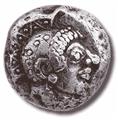
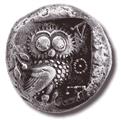
Athena and Phoebus - an alternative name for Apollo - were two of the most important gods of the
Greek Dodecatheonthe were chosen as the two official mascots of the Olympic Games ATHENS 2004. They held
a prominent place in the religious consciousness of the ancient Greeks and their qualities embodied all the
spiritual and moral assets of the Greek civilization. The two gods are the inventors and protectors of all
spiritual creation. Their lives and their myths inspired artists throughout ancient times and their numerous
representations in statues, pots and various works in relief are regarded today as excellent artifacts of highly
conceived art which belong to our universal cultural heritage.
Goddess Athena
Athena was Zeus' favourite daughter. She was beautiful and brave, yet very wise as well. And it
was absolutely natural that she was highly esteemed by the Greeks for it was in her figure that the most important
ideals of the ancient Greek spirit, prudence and bravery, were personified. She was the goddess of wisdom,
protector of cities who ensured the peaceful life of citizens. At the same time she was the goddess of war and
power, the one who would greatly contribute to the final victory in the battlefield. It is no surprise therefore
that she is often represented triumphant (Nikephoros), with a small figure of Nike (Victory) in hand.
Athena is always depicted in full armament - helmet, spear and shield. Her symbols are the owl
and the olive. The myth of Athena's birth is quite impressive. According to tradition, as recorded by Hesiod, one
of Zeus' wives was Metis, the personification of prudence. However, according to an oracle, the child that she
would bear would dethrone Zeus and chase him away from Olympus. Terrified at this thought, Zeus consulted Earth
and Ouranos (Sky god) who prompted him to swallow the woman before she gave birth to the baby. And so he did.
But when the time had come for the child to be delivered, Zeus suffered from such an unbearable
headache that he called for Hephaistos to open his head. It was then that Athena emerged from her father's head,
in full armour, wielding spear and shield. So marvellous was the sight that Olympus and Earth stood still to watch
and even the Sun, awe-struck by the scene, brought his chariot to a halt, until Athena laid down her formidable
weapons. The great Pheidias has inspiringly represented this scene in the east pediment of the Parthenon.
Athena on coins
As the Patron goddess of Athens, it is only natural to expect to see her head on the ancient
coins of the city. Indeed, after a brief period of experimentation concerning the choice of iconography, the
Athenians, some time around 510 B.C., finally arrived at the following iconographic type: Athena's head featured
on the obverse while the reverse displayed her symbol, the owl accompanied by the initials "ATH" and the olive
branch. Athena Glaucopis, the goddess with the intense gaze and the azure piercing eyes, rightfully
deserved the owl - the bird with the glowing eyes - as her symbol. The above iconographic type remained unaltered
for approximately five centuries, until the exclusive circulation of the Roman denarii. The well-known "owls" were
to become the "international" currency of the ancient world, which travelled to regions as distant as India and
Arabia and were widely imitated in Egypt, Syria, Palestine and Bactria.
In the neighbouring region of Corinth, Athena was worshipped as Athena Chalinitis (the Inventor
of the Bridle) and as Athena Hippia (the Rider), names inspired from her association with the myth of Bellerophon
and Pegasus. The latter was the shining horse that emerged from Medusa's neck the moment of her decapitation by
Perseus. According to myth, Bellerophon (a Corinthian hero) requested Athena's help in order to captivate and
tame the horse. One night when he slept in Athena's temple, the goddess appeared in his dream and presented him
with a golden bridle, with which he eventually tamed Pegasus. This myth provides explanation for the image of
Athena along with that of Pegasus on the Corinthian staters, which became known as mules.
The city of Iton in Thessaly, located in the area of Achaia Phthiotis near the Pagasitean gulf,
was home to another temple dedicated to the worship of Athena. The goddess is known here as Athena Itonia and the
Itonian festivals organized by many Thessalian cities to celebrate her bear clear testimony to Crannon. In
Thessaly, Athena's persona as warrior goddess outweighed her other qualities and, characteristically, according to
Pausanias, the Thessalians used her name - Athena Itonia - as a recognition signal at times of war. For this
reason she is featured in full armour holding her shield in the left hand while raising her spear with her right,
ready to strike.
From Thessaly, the worship of Athena spread to Boeotia, and a grand temple was established in
her honour in the site of Koroneia, where the Pan-Boeotian festivals took place. Quite curiously though, Athena's
head is depicted only in certain issues of copper coins.
Our next stop is Crete, the city of Itanos which is located on the east coast of the island
where today's Erimopolis stands. On the coins found here, the obverse iconographic type is that of Athena the
Samonian, a name given to her as the goddess of storm, thunder and lightning.
As an iconographic type, Athena's head is also found in the north Aegean region, on coins of the
Samothrace. Despite being renowned for the magnificent sanctuary of the Kabeiroi, it was Athena that the
inhabitants looked upon as their patron deity and for this reason represented her head on their coins.
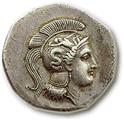
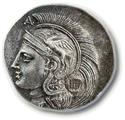
Continuing the journey to the west, we arrive in Great Greece - in particular in the region of
Lucania in southern Italy. Thanks to the Athenians' initiative, and especially Pericles himself, the city of
Thourioi was established on the eastern coast of southern Italy, near the site of the Achaian colony of Sybaris in
the gulf of Tarentum, in 443 B.C. The representation of Athena's head on the local coins is commonly associated
with the Athenian colonists though it should be noted that in the pre-existing Sybaris, there was a temple
honouring Athena Crathie, named after the local river. A similar iconographic type appears on the coins of another
Lucanian city, Hyele or Elea (the roman Velia), on the Tyrrenean coast. In fact, the goddess was embraced in the
wider region of Lucania and a grand temple stood in Poseidonia.
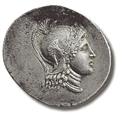
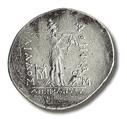
East of Greece, our first stop is in Ilion, the city immortalised as Troy by the great Homer.
The city's tetradrachms exhibit the head of Athena Ilias (of Ilion) on the obverse, while on the reverse the
figure of the goddess is represented in full, holding spear and distaff, accompanied by a vertical inscription of
her name. The temple of Athena Ilias stood at the acropolis Pergamos, in the southeast of the city.
It was home to the Palladion, the wooden statue of Athena, which protected the city and, according to the oracle,
if it was stolen from Troy, the city would fall.
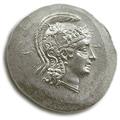
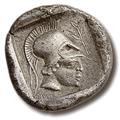
The worship of the goddess seems also to have been widespread in the Ionian region, on the coast
of Asia Minor. On coins of Herakleia - a city erected on the foot of mount Latmos in the Bafa gulf and known today
as Kapikeren - the obverse depicts Athena's head. The worship of Athena, however, extends further in the east,
and in particular in the area of Pamphylia where she is the most prevalent among deities. Here, she was known as
Athena Siditis and her magnificent temple in Side is still preserved today near the port.
Athena was not only regarded as the protector of cities but of royal families as well,
especially in Macedonia, where temples reported to have existed since the 4th century B.C. She was worshipped by
the Macedonian kings as a warrior goddess - protector of their armies as well as themselves - that would lead them
to victory in the battlefield. The goddess' head was chosen by Alexander the Great to adorn the obverse side of
his gold coins, which were widely circulated throughout the ancient world even after his death.
Alexander's faith in Athena was also preserved by his descendants, whose coins bear clear
evidence of her worship. Athena Nikephoros (the Victorious) is represented enthroned on the reverse of the
tetradrachms issued by Lysimachos, son of Agathocles from Crannon in Thessaly, born in 361 B.C. in Pella and one
of Alexander's bodyguards. After the Great king's passing away, Lysimachos took over the satrapy of Thrace and the
coins he issued were in circulation for nearly three centuries after his
death.
In Macedonia particularly, the goddess was embraced as Athena Alkidemos - which means power - and
is represented in warrior stance, ready to hurl her spear while holding the shield in the other hand. The same
representation is featured on the reverse of the tetradrachms issued by Antigonos Gonatas.
Athena Alkidemos is found as far as the boundaries of the Greek world, in Baktria and India, the
farthest point in the east that any Greek army has ever marched. We see the goddess on coins issued by Menander,
the one and only Greek king of India mentioned in Indian literature.